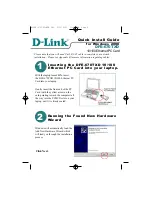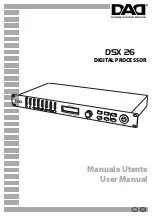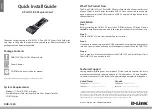
10
VLAN O
VERVIEW
VLAN Overview
Introduction to VLAN
The traditional Ethernet is a flat network, where all hosts are in the same
broadcast domain and connected with each other through hubs or switches. The
hub is a physical layer device without the switching function, so it forwards the
received packet to all ports. The switch is a link layer device which can forward the
packet according to the MAC address of the packet. However, when the switch
receives a broadcast packet or an unknown unicast packet whose MAC address is
not included in the MAC address table of the switch, it will forward the packet to
all the ports except the inbound port of the packet. In this case, a host in the
network receives a lot of packets whose destination is not the host itself. Thus,
plenty of bandwidth resources are wasted, causing potential serious security
problems.
The traditional way to isolate broadcast domains is to use routers. However,
routers are expensive and provide few ports, so they cannot subnet the network
particularly.
The virtual local area network (VLAN) technology is developed for switches to
control broadcast in LANs.
By creating VLANs in a physical LAN, you can divide the LAN into multiple logical
LANs, each of which has a broadcast domain of its own. Hosts in the same VLAN
communicate with each other as if they are in a LAN. However, hosts in different
VLANs cannot communicate with each other directly. Figure 25 illustrates a VLAN
implementation.
Содержание Switch 7754
Страница 32: ...32 CHAPTER 1 CLI OVERVIEW ...
Страница 70: ...70 CHAPTER 5 LOGGING IN USING MODEM ...
Страница 76: ...76 CHAPTER 7 LOGGING IN THROUGH NMS ...
Страница 86: ...86 CHAPTER 9 CONFIGURATION FILE MANAGEMENT ...
Страница 120: ...120 CHAPTER 13 ISOLATE USER VLAN CONFIGURATION ...
Страница 126: ...126 CHAPTER 14 SUPER VLAN ...
Страница 136: ...136 CHAPTER 16 IP PERFORMANCE CONFIGURATION ...
Страница 152: ...152 CHAPTER 17 IPX CONFIGURATION ...
Страница 164: ...164 CHAPTER 19 QINQ CONFIGURATION ...
Страница 172: ...172 CHAPTER 21 SHARED VLAN CONFIGURATION ...
Страница 182: ...182 CHAPTER 22 PORT BASIC CONFIGURATION ...
Страница 198: ...198 CHAPTER 24 PORT ISOLATION CONFIGURATION ...
Страница 208: ...208 CHAPTER 25 PORT SECURITY CONFIGURATION ...
Страница 224: ...224 CHAPTER 27 DLDP CONFIGURATION ...
Страница 232: ...232 CHAPTER 28 MAC ADDRESS TABLE MANAGEMENT ...
Страница 240: ...240 CHAPTER 29 CENTRALIZED MAC ADDRESS AUTHENTICATION CONFIGURATION ...
Страница 280: ...280 CHAPTER 30 MSTP CONFIGURATION ...
Страница 348: ...348 CHAPTER 35 IS IS CONFIGURATION ...
Страница 408: ...408 CHAPTER 39 802 1X CONFIGURATION ...
Страница 412: ...412 CHAPTER 40 HABP CONFIGURATION ...
Страница 422: ...422 CHAPTER 41 MULTICAST OVERVIEW ...
Страница 426: ...426 CHAPTER 42 GMRP CONFIGURATION ...
Страница 480: ...480 CHAPTER 47 PIM CONFIGURATION ...
Страница 506: ...506 CHAPTER 48 MSDP CONFIGURATION ...
Страница 552: ...552 CHAPTER 51 TRAFFIC ACCOUNTING CONFIGURATION ...
Страница 570: ...570 CHAPTER 53 HA CONFIGURATION ...
Страница 582: ...582 CHAPTER 54 ARP CONFIGURATION SwitchA arp protective down recover interval 200 ...
Страница 622: ...622 CHAPTER 58 DHCP RELAY AGENT CONFIGURATION ...
Страница 684: ...684 CHAPTER 61 QOS CONFIGURATION ...
Страница 718: ...718 CHAPTER 63 CLUSTER ...
Страница 738: ...738 CHAPTER 67 UDP HELPER CONFIGURATION ...
Страница 752: ...752 CHAPTER 69 RMON CONFIGURATION ...
Страница 772: ...772 CHAPTER 70 NTP CONFIGURATION ...
Страница 796: ...796 CHAPTER 72 FILE SYSTEM MANAGEMENT ...
Страница 802: ...802 CHAPTER 73 BIMS CONFIGURATION ...
Страница 814: ...814 CHAPTER 74 FTP AND TFTP CONFIGURATION ...
Страница 830: ...830 CHAPTER 75 INFORMATION CENTER ...
Страница 836: ...836 CHAPTER 76 DNS CONFIGURATION ...
Страница 852: ...852 CHAPTER 77 BOOTROM AND HOST SOFTWARE LOADING ...
Страница 858: ...858 CHAPTER 78 BASIC SYSTEM CONFIGURATION DEBUGGING ...
















































